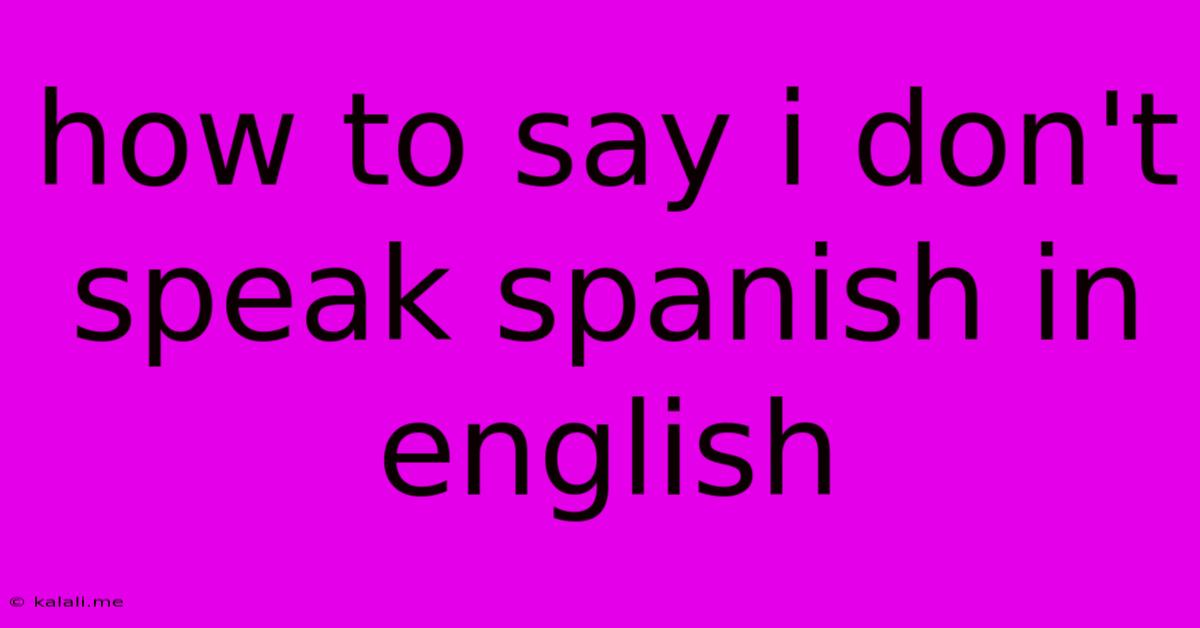How To Say I Don't Speak Spanish In English
Kalali
May 25, 2025 · 3 min read

Table of Contents
How to Say "I Don't Speak Spanish" in English: A Comprehensive Guide
This article provides a comprehensive guide on how to politely and effectively communicate your lack of Spanish proficiency in English. Knowing how to express this simple fact can prevent misunderstandings and ensure smoother interactions, whether you're traveling, working, or simply meeting someone new. We'll explore various phrases, their nuances, and appropriate contexts for use.
Direct and Simple Phrases
The most straightforward way to convey that you don't speak Spanish is to use a simple, direct statement. Here are a few options:
- "I don't speak Spanish." This is the most common and easily understood phrase. It's direct, clear, and leaves no room for misinterpretation.
- "I don't understand Spanish." This emphasizes your inability to comprehend the language, which might be helpful if someone is speaking to you in Spanish.
- "No hablo español." While technically Spanish, this phrase is widely understood and accepted as a polite way to express your lack of fluency. Including this demonstrates a willingness to communicate, even if you can't use the language itself.
Adding Politeness and Context
While the above phrases are effective, adding a touch of politeness can significantly improve the interaction. Consider these additions:
- "I'm sorry, I don't speak Spanish." The addition of "I'm sorry" expresses regret for the communication barrier, making the interaction more pleasant.
- "I don't speak Spanish, but..." Follow this with a suggestion, such as:
- "...I can try to understand." Shows willingness to attempt communication despite limitations.
- "...I speak English." Clearly states your preferred language.
- "...do you speak English?" Directly asks if they can communicate in your preferred language.
- "Excuse me, I don't speak Spanish. Do you speak English?" This is a polite and direct approach, suitable for formal settings or when approaching a stranger.
Handling Different Situations
The best way to express your lack of Spanish fluency depends heavily on the context:
- Formal Settings (e.g., business meeting): Opt for more formal phrases like "Excuse me, I do not speak Spanish. Would you be able to communicate in English?"
- Informal Settings (e.g., casual conversation): Simpler phrases like "I don't speak Spanish" or "I don't understand Spanish" are perfectly acceptable.
- Travel: Having a phrasebook or translation app readily available can help bridge the communication gap, even if you don't speak the language fluently. You can say, "I don't speak Spanish, but I have a translator."
Beyond the Basics: Showing Understanding and Initiative
Even if you don't speak Spanish, you can still demonstrate understanding and a willingness to communicate:
- Non-verbal cues: Smiling, nodding, and using gestures can help convey your understanding and attentiveness, even if you can't comprehend the spoken words.
- Using technology: Translation apps can assist in real-time translation, facilitating communication even if your Spanish is nonexistent.
Mastering these phrases and approaches ensures smoother interactions and builds positive connections, even with a language barrier. Remember, politeness and a willingness to communicate go a long way.
Latest Posts
Latest Posts
-
How To Uninstall Grub On Command Line
May 26, 2025
-
How To Spell Great In Spanish
May 26, 2025
-
Resolve Cassandra Does Not Return Data
May 26, 2025
-
Apache Show Relative Path In Browser
May 26, 2025
-
Mirror Compete Magic Tracpad Orientaion For
May 26, 2025
Related Post
Thank you for visiting our website which covers about How To Say I Don't Speak Spanish In English . We hope the information provided has been useful to you. Feel free to contact us if you have any questions or need further assistance. See you next time and don't miss to bookmark.